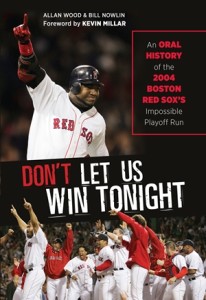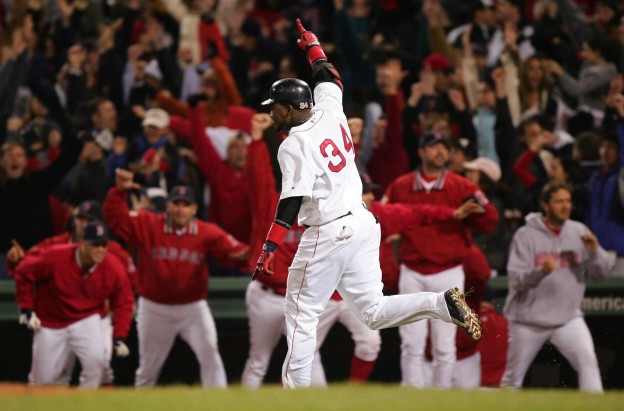It’s almost with sad reserve that we open the 2005 season after Red Sox fans enjoyed the fruits of a successful 2004 campaign. Yes, Boston will often be referred to as the defending World Series champions this season but, for all intent and purpose, last season’s amazing accomplishment doesn’t count for anything in this year’s standings. Still, with renewed enthusiasm, this team is looking to realize something even more astounding: repeating as champions for the first time since the Red Sox won back-to-back titles in 1915 and 1916. The team returns looking pretty much the same as last season’s squad, even with a few additions and subtractions, so how will this season compare to last? Hopefully we answer some of those questions here.
How much with the loss of Derek Lowe and Pedro Martinez hurt?
Both guys played key roles in the 2004 post-season; Lowe was the winning pitcher in all three series-clinching games and Martinez dazzled in his only World Series appearance. They also combined to win 30 games during the regular season and both stayed healthy for the entire season. Only time will tell if Matt Clement, Wade Miller, and David Wells will be able to combine their efforts to repeat, but we have to remember that the Sox also have one of the best lineups at the plate. While the win totals were impressive, both Lowe and Martinez had their earned-run averages jump considerably, combining for a 4.59 ERA. Lowe’s 5.42 ERA was almost three runs higher than his stellar 2002 campaign numbers, and Martinez’s 3.90 ERA was almost double his Red Sox career average. The point is that, barring an unlikely drop-off in production at the plate, the Sox will continue to win, even with these two wearing different uniforms this season.
Should we be concerned with Curt Schilling missing the opener?
If you believe Schilling, the only reason that he is heading to the DL to start the season is because he needs another week or so to work on his mechanics. His infamous ankle, which was surgically repaired last November nearly a week after the World Series ended, is not the problem; it has fully healed and trainers gave him the green light early enough in spring training that he would otherwise be in the Bronx next Sunday night to open the season for Boston. Luckily, the Sox have enough off days during the first two weeks of the season to go with a four-man rotation and Schilling should be available before the schedule becomes more demanding.
Has Edgar Renteria stabilized the shortstop position?
Renteria should cement himself in that position for many years to come, especially given that the Sox signed him to a four-year contract at $10 million per season. He is a year younger than fellow Colombian Orlando Cabrera, whom he replaces in the Red Sox lineup and a couple years younger than Nomar Garciaparra, who seemed to be a permanent fixture in Boston until last year. Like Cabrera, he is a Gold Glove winner and has flashed the leather many times this spring, already winning over the hearts of Red Sox fans. He also adds more punch in the lineup, with a lifetime batting average of .289 and 10 or more home runs each season over the last six years. Prospect Hanley Ramirez, who impressed coaches and the front office this spring, waits in the wings in Portland but don’t be surprised if he’s never seen in Boston, so long as Renteria performs as expected.
What more can we expect from David Ortiz this season?
There is just so much beauty in that man’s swing, it almost brings a tear to my eye. Looking at his statistics from last season through the regular season and into the playoffs, it’s just amazing what he has done since the Sox picked him off waivers from Minnesota. Last year, “Big Papi” amassed 41 home runs and 139 RBI, spending more than three-quarters of the time in the DH role, and his post-season heroics earned him MVP honors in the American League Championship Series. This spring, it’s evident that his powerful stroke has not diminished, even if he’s taken off a few pounds during the off-season. Terry Francona expects to use him as the everyday DH, so there’s no reason that he can’t continue to compile the numbers that make jaws drop everywhere.
Who will be the surprise of the season?
Jay Payton grabbed headlines when he was traded to Boston in December for Dave Roberts, but perhaps overlooked in that deal was the acquisition of infielder Ramon Vazquez. The four-year veteran from Puerto Rico, who has averaged 78 games in that time, plays all four infield positions and sports a .979 fielding percentage. Remember how valuable Pokey Reese was for Boston last season? Perhaps he might not get as many opportunities as Pokey, who took advantage of Nomar’s absence for the first half of the season, but he should prove valuable as a late-inning defensive replacement. Plus, when one of the veterans needs an off-day to recover from aches and pains, Vazquez should prove adequate with a .262 lifetime average.
Will Adam Stern remain with Boston for the entire season?
Being a Rule V pick-up, Stern would be shipped back to the Atlanta Braves if the Sox are unable to find a permanent place for him on the major league roster. Unfortunately, there are five Red Sox outfielders in front of him: Manny Ramirez, Johnny Damon, Trot Nixon, Payton, and Kevin Millar. Adam Hyzdu has already been sent packing this spring for that very reason. Barring an injury to one of the fore mentioned players, Boston will not jump through hoops to retain his services, so expect him back with Atlanta by mid-summer.
Isn’t Francona deserving of an extension now?
Francona managed in his first year at the Red Sox helm to win a World Series championship, something that no Boston manager had done since Ed Barrow, also in his first season as manager, in 1918. To some, that would seem like reason enough to sign him to a new contract right now; however, the Red Sox front office is not going to rush to get him guaranteed for anything past the current length of their agreement with him, at least through this season. Should his fortunes continue, then it’s possible that he would be granted an extension after that, as well as a statue right next to Ted Williams‘s, but both Francona and the Sox are content to let sleeping dogs lie for now.
Will they or won’t they?
It bears repeating that all roads to the championship will lead through New York and the Yankees spent the winter reloading the arsenal as usual. However, the Red Sox are just as strong themselves and should be able to rise to the challenge once more. Winning the division has become inconsequential thanks to the Wild Card draw; Boston should do well enough again to earn at least that prize and make the playoffs. As long as they play to their potential and Francona continues to make smart coaching decisions, the Red Sox should get another chance to meet a National League opponent in late October for all the marbles.

